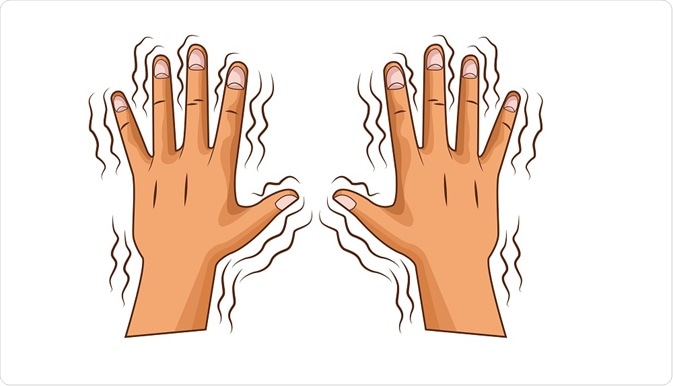Movement disorders are neurological conditions that characteristically affect the speed, fluency, quality, and ease of voluntary muscle movements. These may affect activities of daily living (ADL), or simple day-to-day tasks such as writing or walking.
 Jemastock | Shutterstock
Jemastock | Shutterstock
Movement disorders may cover a wide range of severity and are often debilitating illnesses. There are various types of movement disorders. These include tremor, Parkinson’s disease and so forth. (1-5)
Tremors
Essential tremor
The most common movement disorder is essential tremor. It affects one in 20 people under the age of 40 years and one in five people over 65 years.
The disorder is characterized by involuntary shaking movements of the hand or fingers, or less commonly, other parts of the body, on attempting to hold them up or to perform a task. The tremors are usually rhythmic or pendulous in nature.
Essential tremor usually affects the hands and feet, but voice tremors and head tremors are also seen. The condition may be severely disabling in the long term.
Physiological tremor
This is a faint tremor that is sometimes triggered by nervousness or other stimuli. The tremor may be exacerbated or become more constant in the presence of stress, exercise, weakness, or an overactive thyroid gland.
Parkinson’s disease
Parkinson’s disease is a severely debilitating progressive neurological condition that affects one in 500 individuals. The cause of PD remains unknown, but it is thought to have genetic and environmental components.
Parkinson’s disease is characterized by rigidity of muscles, facial immobility, tremors and a shortened “shuffling” gait. Eventually, the patient may be unable to cope with ADL and may have to depend on a caregiver.
Dyskinesia
Dyskinesia literally means abnormal (dys) movements (kinesia). It is characterized by spasms, tics and twitches;by more complex slow writhing movements (athetosis); rapid, jerky movements (chorea); or spasm of a group of muscles (dystonia).
Sometimes the main symptom may be hypokinesia or paucity of movement; akinesia, or lack of movements; and bradykinesia, or slowing of movements. These are all commonly seen in Parkinson’s disease and other similar conditions.
These complex abnormalities of movement may appear slowly or may have an acute onset, with an unpredictable course, and a rapid return to normal.
Dyskinesia may be induced by certain drugs used to treat Parkinson’s disease, or by some antipsychotic medications used in the therapy of specific psychiatric conditions.
Dystonia
Dystonia is characterized by sustained spasm or contraction of a group of muscles as well as of other muscles that are not necessary for the movement, and of antagonistic muscles. This may lead to sometimes painful writhing movements or abnormally held postures.
Writer's cramp is an example of focal dystonia that affects the fingers of the writing hand. It is often sudden in onset and disappears spontaneously on rest.
Similarly, dystonia may affect the eyelids leading to blepharospasm. This manifests as increased blinking and involuntary closing of the eyes.
Tired, stressed muscles are prone to dystonia. Anxiety and sharp emotions may also trigger dystonias.
Tics
These are small repetitive movements or twitches of a group of muscles. The movements that may result include blinking, shrugging, grunting or grimacing.
Dysphonia
There are abnormal movements of the muscles involved in voice production and speech. The voice becomes quivery, jerky or strained and hoarse as a result.
Ataxia
This disorder affects balance and the control of muscles involved in walking, running and other locomotor activities. It involves defects in posture maintenance as well as in the control of coordination, and may manifest as lurching or staggering movements.
Ataxia is usually a symptom of conditions such as multiple sclerosis or cerebral palsy rather than being a disease in itself. It is caused by diseases of the cerebellum or of the base of the brain. Alcohol consumption is a common cause of ataxia.
Restless legs syndrome
This is a fairly common movement disorder affecting one in 10 individuals. There are intensely uncomfortable sensations in the legs and sometimes in the arms, typically occurring at bedtime or during rest.
The sensation may be felt as tingling or creeping, and is relieved by movement of the limbs. This condition may lead to disturbed sleep and insomnia.
Huntington’s disease
This is a genetic condition that affects muscle movements because of the atrophy of voluntary motor neurons in some parts of the brain. The patient develops chronic progressive chorea or rapid jerky purposeless movements of various groups of muscles. In addition the patient shows emotional, behavioral, and psychiatric abnormalities.
Other movement disorders
Various other movement disorders include:
- Myoclonus: rapid, uncontrolled, brief and irregular movements of a group of muscles
- Multiple system atrophy, or Shy-Drager syndrome, is caused by degeneration of neurons in certain parts of the brain and spinal cord, resulting in a Parkinsonian picture with autonomic instability leading to orthostatic hypotension.
- Progressive supranuclear palsy (PSP): a rare movement disorder that affects purposeful movements
- Tourette’s syndrome: characterized by various tics and grunts
- Wilson’s disease: caused by excessive deposition of copper in the body, leading to neurological and psychiatric symptoms along with liver disease
- Drug-induced movement disorders: Abnormal movements, tremor, dystonia and dyskinesias may be associated with certain drugs. These could include antipsychotic medications or other medications which affect the central nervous system.
Further Reading
Last Updated: Nov 16, 2018